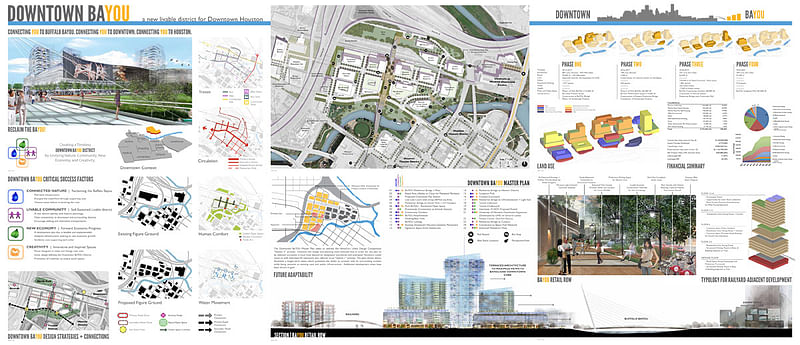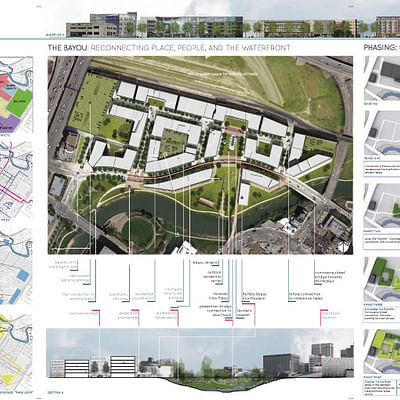ULI/Hines Competition Announces the 2012 Finalists + Honorable Mentions
By Bustler Editors|
Monday, Mar 5, 2012

Related
Graduate-level student teams representing the University of California-Berkeley, Columbia University, the University of Michigan, and a joint team from the University of Colorado and Harvard University have been selected as finalists for the tenth annual Urban Land Institute (ULI) Gerald D. Hines Student Urban Design Competition. This year’s finalists were charged with proposing a long-term vision for creating a distinct identity for a new downtown Houston district.
Participating interdisciplinary teams were challenged with creating a practical and workable scheme for the best use of approximately 16.3 acres owned by the United States Postal Service (USPS). The competition focuses on the USPS property since it is considered by many stakeholders to be a key site to reconnect the Theater District, the Historic District, and the greater downtown to the Buffalo Bayou. The downtown post office was one of several hundred USPS properties put up for sale nation-wide in 2009 to offset the federal agency’s financial losses. Since that time, land planners and real estate experts have suggested numerous possibilities for the property, which have included converting the land into public open space, mixed-use development that includes residential housing, as well entertainment venues.
The competition is based on a hypothetical proposal in which a fictional entity, the Central Houston Foundation (CHF), has acquired the option to purchase the site and establish redevelopment goals and connections to the surrounding areas. According to the scenario, the CHF has committed a large endowment to both community development and the sustainable growth of Houston’s downtown in hopes of generating a revenue stream for its endowment, while giving shape to a new downtown district. In order to meet the owners’ demands, the student teams are acting as a master developer by proposing a master land use plan for the development site as well as supplying financial projections needed to support the master development plan.
While based on a hypothetical situation, the 2012 Hines competition addresses local groups’ desire to connect downtown redevelopment to incorporate connections to Houston’s neighborhoods. Houston’s downtown is the center of the city’s transit network, providing downtown workers with a variety of commuting options that include light rail, buses, vanpools, and carpools.
The development schemes from the finalist teams are:
University of California - Berkeley: “The Grand”
Students: Deepak Sohane (Master of Urban Design), Brian Chambers (Master of Urban Design), Carlos Emilio Sandoval Olascoaga (Master of Architecture), Jim Farris (MBA), Momin Mahammad (Master of Urban Design)
Faculty Adviser: Peter Bosselmann
“The Grand” proposes an elaborate network of public space fronting on the Buffalo Bayou, including community gardens, open space, and a kayak/canoe launch area that connects to the already-built open space across the water – creating an important new node along the Bayou. Washington Street is brought into the site as a primary corridor, linking with both downtown and the redevelopment to the west. The proposal aims to introduce high residential and commercial densities to the north of Washington Street with easy access to a potential commuter rail/Amtrak station onsite. - Competiton Board (PDF)


University of Colorado/Harvard University (joint team): “Downtown Bayou”
Students: Chad Murphy (MBA Real Estate), Alex Atherton (MBA Real Estate), Michael Albert (Master of Landscape Architecture), Anna Cawrse (Master of Landscape Architecture), Victor Perez Amado (Master of Architecture)
Faculty Adviser: Anita Berrizbeitia
Professional Advisor: Todd Johnson
“Downtown Bayou” creates a residential neighborhood in downtown Houston with a distinct focus on connecting residents and workers to the Bayou and the rest of downtown. A pedestrian corridor that cuts through the site links the Cultural District with new restaurants, offices, condos/apartments along with an open green space to the north of the rail yard. A walkable scale is created by the introduction of new blocks, along with shifting Franklin Street north while maintaining its overall capacity. - Competiton Board (PDF)

Columbia University: “The Post”
Students: Jennifer Chung (Master of Real Estate Development), Wendy Hoffman (Master of Real Estate Development), Jose Franco Soberano (Master of Real Estate Development), Zachary Craun (Master of Architecture and Urban Design), Farzin Lotfi-Jam (Master of Advanced Architectural Design)
Faculty Adviser: Jesse Keenan
By maintaining the existing USPS office building and converting it into a center for artists, workshops, and incubator office space, “The Post” creates a cultural center within the site to complement the adjacent cultural district. It also introduces roof-top entertainment such as cinemas and eateries to capitalize on the site’s views of downtown and beyond. Residential development maintains a human scale while providing housing for over 2500 people at all income levels. A portion of the USPS distribution facility is also retained, and will be renovated to house a small-vendor produce market. - Competiton Board (PDF)

University of Michigan: “The Hill”
Students: Jessica Hester (Master of Science in Design Research), Laura Reading (Master in Urban Planning), Reid Fellenbaum (Master in Architecture), Anne Fennema (Master in Urban Planning), Sylvia Harris (Master in Urban Planning)
Faculty Adviser: Suzanne Lanyi Charles
“The Hill” envisions a new livable downtown district in Houston through connections to the University of Houston’s Downtown and the Buffalo Bayou through the creation of diverse housing stock and unique parks. The “Houston Highline” park connects from the bayou into the heart of the site, linking Houston’s Historic and Cultural Districts with this live-work-play community. Buildings gradually decrease in height towards the bayou, giving the project a distinctive architectural identity while connectivity is enhanced by a new network of walkable blocks and a transit center. - Competiton Board (PDF)

According to competition jury chairman and longtime ULI leader James Chaffin, the four finalists took a holistic approach to how the site was connected to and affected by the area around it. “These students were very aware of who they were designing these places for, whether it was for a younger generation looking for a different type of experience, or an older generation looking not for assisted living, but easy living that is not committed to an automobile,” said Chaffin, chairman of Chaffin/Light Associates, LLC in Okatie, S.C. “This generation of students is very committed to transit-oriented development. The way it [public transit] was incorporated into the site so that it is an easy and celebrated part of the solution is an expression of how this generation does not want to be dependent on the automobile.”
The competition jury consists of renowned experts in urban planning, design and development. In addition to Chaffin, other jury members are: Gerdo Aquino, president/principal, SWA Group, Los Angeles, Calif.; Mimi Burns, principal, Dekker/Perich/Sabatini, Albuquerque, N.M; Anyeley Hallova, partner, Project Ecological Development, Portland, Ore.; Richard Heapes, principal, Street Works, White Plains, N.Y.; Sandra Kulli, president, Kulli Marketing, Malibu, Calif.; Michael Lander, president and owner, The Lander Group, Inc., Minneapolis, Minn.; Alan Mountjoy, principal, Chan Krieger/NBBJ, Cambridge, Mass.; Greg Shannon, President, Sedona Pacific Corporation, San Diego, Calif.; and Tim Van Meter, partner, Van Meter, Williams Pollack, LLP, Denver, Colo.
Nine teams were also selected for honorable mention. The jury commended the University of Houston with “Houston’s Urban Bayou Neighborhood” for superior financials; Harvard University with “Tread Lightly, Texas!” for superior site planning; the University of Virginia with “Green Tech Corridor” for superior focus on job creation; the University of Texas at Austin with “Global Ideas: Grown in Texas” for superior focus on demographics; the University of Pennsylvania with “Infiltrate” for superior focus on water treatment; and Ball State University with “EcoEdge” for superior presentation graphics. Three honorable mentions for overall merit were awarded to the University of Oklahoma with “The Foundry;” the Georgia Institute of Technology with “Artesano;” and the University of Oklahoma with “The Veranda.”
In the final phase of the 2012 competition, which concludes on April 6, each of the final four teams will be given the opportunity to expand their original schemes and respond in more detail. On April 5-6, finalist team members will present their schemes to the competition jury during a public forum in Houston. The event will culminate with the announcement of the winning team. The competition is designed as an exercise; there is no intention that the students’ plans will be implemented as part of any development of the site.
For images of some of the selected Honorable Mentions, please see the image gallery below.







Share
0 Comments
Comment as :